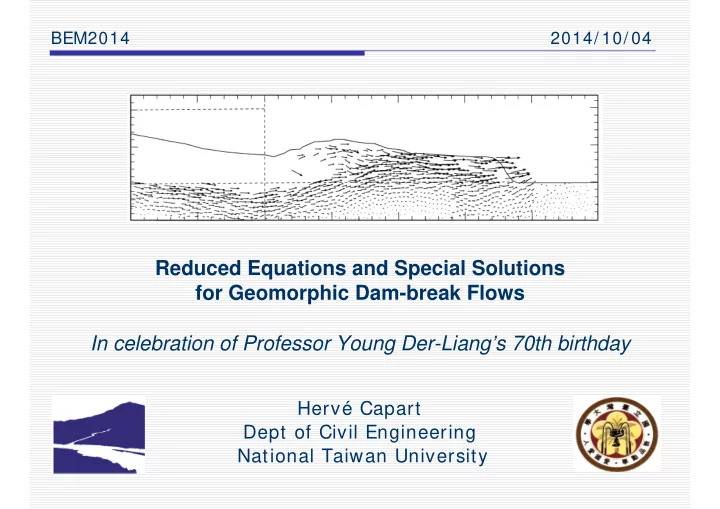

BEM2014 2014/ 10/ 04 Reduced Equations and Special Solutions for Geomorphic Dam-break Flows In celebration of Professor Young Der-Liang’s 70th birthday Hervé Capart Dept of Civil Engineering National Taiwan University
Sources 2 Capart, H., and D.L. Young (1998) Formation of a jump by the dam- break wave over a granular bed. Journal of Fluid Mechanics 372, 165– 187. Fraccarollo, L., and H. Capart (2002) Riemann wave description of erosional dam-break flows. Journal of Fluid Mechanics 461, 183–228. Capart, H., M. Bellal, and D.L. Young (2007) Self-similar evolution of semi-infinite alluvial channels with moving boundaries. Journal of Sedimentary Research 77, 13-22. Hsu, J.P.C., and H. Capart (2008) Onset and growth of tributary-dammed lakes. Water Resources Research 44(11), W11201. Spinewine, B., and Capart, H. (2013) Intense bed-load due to a sudden dam-break. Journal of Fluid Mechanics 731, 579-614. Capart, H. (2013) Analytical solutions for gradual dam breaching and downstream river flooding. Water Resources Research 49(4), 1968- 1987.
Geomorphic dam break and dam breach flows 3 Dam break: sudden failure of rigid dam Example: Balin check dam, September 2007 NTU-MHRG Sudden water release produces geomorphic change. Dam breach: Gradual failure of loose dam Example: Tangjiashan landslide dam, June 2008 Xinhua Water outflow and geomorphic change drive each other.
Research strategy 4 How to make these problems mathematically tractable ? 1) Use lab and field observations to guide the mathematics 2) Cast the flows as m oving boundary problems. 3) Exploit similarity and quasi-linearity to find special solutions .
Taipei dam break experiments (Capart and Young, 1998) 5
Louvain dam break experiments (Spinewine and Capart, 2013) 6
7 Evolving boundaries
8 Experimental Vertical flow structure Theoretical
9 Semi-empirical closure relations
Depth-integrated governing equations (Spinewine and Capart, 2013) 10 ~ z h u 0 t x h cu ( z c h c ) 0 0 t x h u z 2 ( h u h ) t x x
Quasi-linear hyperbolic equations 11 Homogeneous hyperbolic system W W B ( W ) 0 t x Eigenstructure ( i ) ( i ) BK K i
Riemann wave solution (Fraccarollo and Capart, 2002) 12 Self-similar expansion t W ( x , t ) W ( x / t ) Integrate across simple wave dW dW dW 1 2 3 ( i ) ( i ) ( i ) K K K 1 2 3 x i t
13 Comparison with experiments
14 Predicted velocity and concentration maps
Detailed comparisons with experiments (Spinewine and Capart, 2013) 15
Dam breach example: 2009 Namaxia debris dam 16 Forestry Bureau, Taiwan
Alluvial diffusion theory (Capart, Bellal, Young, 2007; Hsu and Capart, 2008) 17 Water-driven diffusion 2 z z s w KQ 0 2 t x Complementary constraints on water surface profile z w z w 0 ( z ( z h )) 0 z z h w s 0 w s 0 x x
Self-similar behavior (Capart, Bellal and Young, 2007) 18 Diffusion problem 2 z z s s KQ ( t ) 0 2 t x x x C t ( ) Self-similar solution z s x f Qdt Qdt x C Qdt
Dam breach solution (Capart, 2013) 19 S.Y.J. Lai dz ( t ) L A Q ( t ) L dt 1 / 2 3 / 2 8 Q ( t ) bg ( t ) 27 ( t ) R Qdt D
Reduction to a pair of autonomous ODEs 20 ODE pair 3 / 2 d ( t ) dt 3 / 2 d ( t ) 3 / 2 dt Solution 2 ( ) 2 2 2 t t ( ) 2 1 4 1 t 8
Solution plots 21 Breach drop ˆ 2 ( t ) t ˆ 2 d t 1 B Discharge hydrograph ˆ 3 Q ( t ) 8 t 2 3 ˆ Q ( 1 t ) P t t ˆ T P
22 Application to 1996 Lake Ha! Ha! dyke breach GSC
Comparison with more field events 23 C B Xinhua / GSC
Flood wave routing to the downstream valley 24 S.Y.J. Lai Kinematic wave equation 8 gS h 3 h 1 / 2 V h 0 t 2 f x
25 Solution by the method of characteristics
Wave profile evolution and discharge hydrographs at downstream stations 26
Comparison with 2008 Tangjiashan landslide dam breach flood 27
Conclusions 28 For both dam break and dam breach problems: 1) Reduced equations provide good approximations of real behavior. 2) Similarity and quasi-linearity can be exploited to find useful special solutions.
29 Acknowledgements and thanks
30 Acknowledgements and thanks
Recommend
More recommend